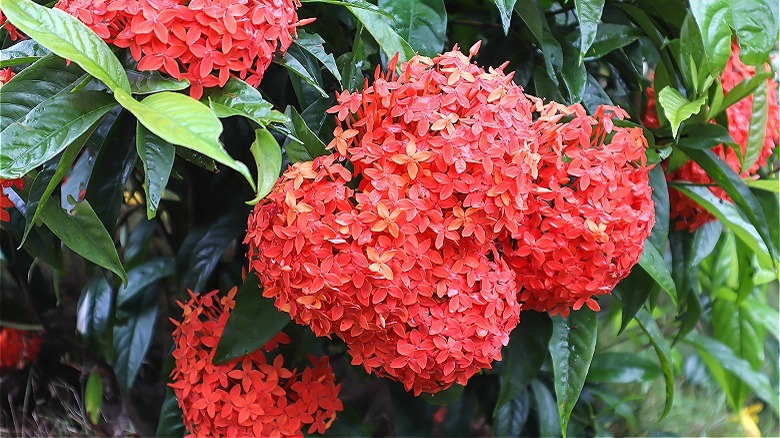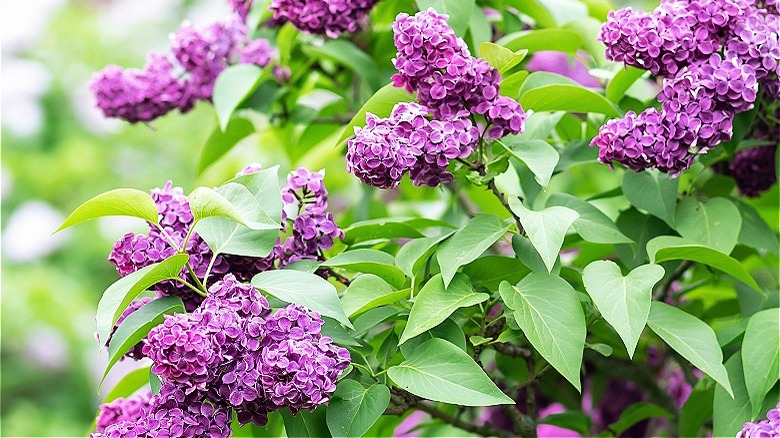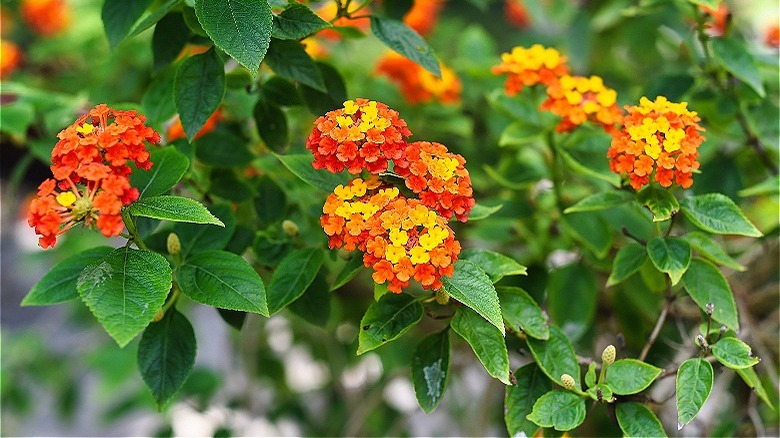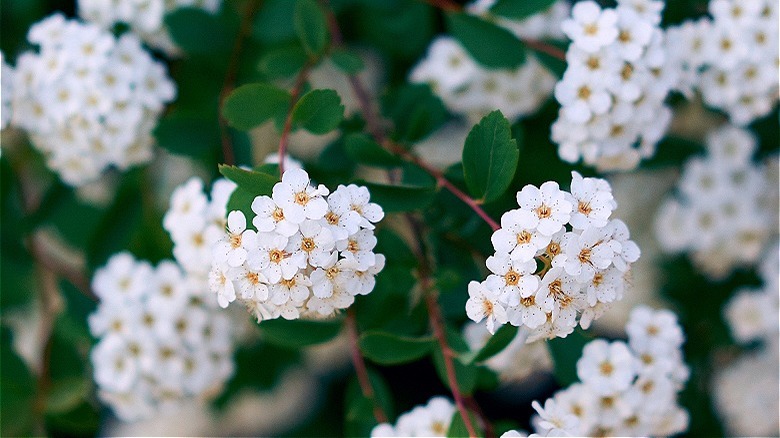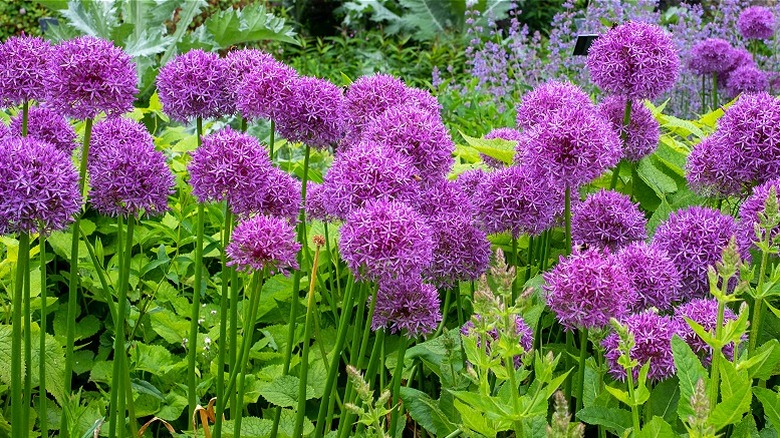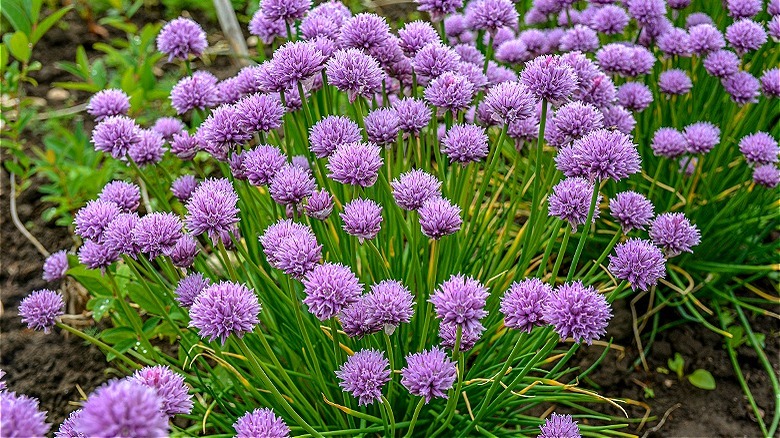15 Flowers You'll Adore If You Love Hydrangeas
If you love the look of hydrangeas (Hydrangea) but are unable to grow them in your zone, or perhaps would simply like to find similar-looking flowers for your garden bed, then you're in luck. From rhododendrons to peonies to chives, there are myriad flowers that offer a similar look to hydrangea and like hydrangea, come in an array of colors. While it's true it's tough to beat the appeal of a big-leaf hydrangea, you'll find in the following list shrubs, trees, and ground flowers that are just as captivating and complementary for a backyard space.
Hydrangeas, commonly known as hortensia, are a beloved genus of plants, known for their beautiful and showy blooms. The charming flower is a favorite amongst landscapers and home gardeners, and the most common of its species, the big leaf hydrangea, offers whimsical ball-like structures that add instant, beautiful dimension to wherever they're grown. They range in color from soft purple to red and can grow as large as 6 feet wide and 20 feet tall. In our list of flowers you'll adore if you love hydrangeas, you'll find smaller varieties, along with some that can grow as tall as wide as the popular hortensia.
1. Rhododendron
Rhododendron, like hydrangea, is a flowering bush with round clusters of petals. The flowers grow in many colors, including pink, purple, yellow, white, and red. Rhododendrons are larger than hydrangeas with some varieties being 20 feet wide. Their size and vibrancy make them an excellent border flower.
Bloom Season: Spring through fall
USDA Growing Zone: 3 to 11
Growing Conditions: Partial sun, shade
Soil Type: Acidic
Size: 6 to 10 feet tall, 5 to 8 feet wide (typically)
2. Ixora
Ixoras (Ixora coccinea) look like tropical hydrangeas and thrive in warmer climates. Though they're showy and bright, ixoras are beginner-friendly and in the proper conditions, they can bloom year-round. If you like the hydrangea look but live in zones 9 or above, you'll love ixoras.
Bloom Season: Evergreen
USDA Growing Zone: 9 to 11
Growing Conditions: Indirect sun
Soil Type: Well-draining
Size: 10 to 15 feet tall, 4 to 10 feet wide
3. Snowball bush viburnum
The European snowball bush (Viburnum macrocephalum) has a delicate and traditional look much like hydrangeas. Some remain a perfect snowy white while others fade into a soft pink. They have an inviting appearance and are well-suited to line walkways and anywhere there's foot traffic.
Bloom Season: Spring through Fall
USDA Growing Zone: 6 to 9
Growing Conditions: Full sun, partial shade
Soil Type: Acidic, well-draining
Size: 6 to 25 feet tall, 10 to 20 feet wide
4. French lilac
Lilac (Syringa vulgaris) is a popular flower famous for its beautiful color and fragrance. It also grows in clusters similar to hydrangeas, but the blooms can grow more oval-shaped. So, they bring texture and height to a garden.
Bloom Season: Mid-Spring
USDA Growing Zone: 3 to 7a
Growing Conditions: Full sun, partial shade
Soil Type: Neutral or alkaline, lilac does not thrive in acidic soil
Size: 8 to 16 feet tall, 6 to 12 feet wide
5. African marigolds
African marigolds (Tagetes erecta) are ground flowers that have round blooms and soft petals. They come in warm colors and while they add drama to a landscape, they're quite easy to grow. As an added benefit, they smell awful to deer and rabbits that may want to feast on other plants in your garden.
Bloom Season: Early summer to late fall
USDA Growing Zone: 2 to 11
Growing Conditions: Full sun
Soil Type: Loamy, sandy, or clay soil with an acidic, alkaline, or neutral pH
Size: 2 to 4 feet tall, up to 18 inches wide
6. Lantana
Lantana (Lantana camara) blooms are smaller than hydrangeas but no less magnificent. The flowers grow in clusters with eye-catching colors and patterns. Lantanas are drought-resistant and thrive in sunny, warm climates, so they're great for regions where more delicate flowers would wilt.
Bloom Season: Late spring, year-round in warm climates
USDA Growing Zone: 7 to 11
Growing Conditions: Full sun
Soil Type: Moist, well-drained soil
Size: 1 to 6 feet tall, 3 to 5 feet wide
7. Egyptian starcluster
If the flower clusters attract you to the hydrangea, you might like the Egyptian starcluster (Pentas lanceolata). Unlike hydrangeas, starclusters have pointed star-shaped flowers. They add texture to a garden and come in white and a variety of pinks, purples, and reds.
Bloom Season: Summer
USDA Growing Zone: 10 to 11
Growing Conditions: Full sun, partial shade
Soil Type: Acidic
Size: 1 to 2 feet tall, 1 to 2 feet wide
8. Spirea
Spirea (Sorbaria sorbifolia) is an impressive plant that is both large and in charge, yet adorable. Though its flowers are smaller than those of a hydrangea, spirea still provides a lot of color. It can even have a dramatic overgrown appearance perfect for blending into large garden displays.
Bloom Season: Mid-spring
USDA Growing Zone: 2 to 8
Growing Conditions: Full sun, partial shade
Soil Type: Moist with a high volume of organic matter
Size: 5 to 10 feet tall, 5 to 10 feet wide
9. Crape myrtle
Crape myrtles (Lagerstroemia) have a showy appearance that rivals the hydrangea. There are multiple bush and tree varieties that you can incorporate into your garden. Crape myrtles thrive in full sun and warm temperatures. Smaller varieties make great borders, while larger crape myrtles are attractive focal points.
Bloom Season: Summer
USDA Growing Zone: 7 to 10
Growing Conditions: Full sun
Soil Type: Well-draining, clay
Size: 5 to 20 feet tall, 5 to 20 feet wide
10. Heliotrope
The purple flowers of the heliotrope (Heliotropium) aren't just rich in color, they smell amazing. Many gardeners liken the scent to almond with a touch of sweetness. Heliotrope grows best in zones 10 and 11 and does quite well in a container.
Bloom Season: Spring, year-round in warm climates
USDA Growing Zone: 3 to 10
Growing Conditions: Full sun, partial shade
Soil Type: Moist, well-draining
Size: 1 to 4 feet tall, 1 to 2 feet wide
11. Butterfly bush
The butterfly bush (Buddleja davidii) may not have spherical clusters like a hydrangea, but it has much of the same appeal. It is bold, large, and comes in bright pink and purple. Its flowers grow together in tall pointed groups and as the name suggests, are especially inviting to butterflies.
Bloom Season: Summer to fall
USDA Growing Zone: 5 to 9
Growing Conditions: Full sun
Soil Type: Neutral pH
Size: 5 to 12 feet tall, 8 to 10 feet wide
12. Pompon or ball dahlia
There are many types of dahlia, but ball and pompon dahlias have spherical flower clusters like hydrangeas. Dahlias are flashy flowers with layers upon layers of brightly colored petals and they range in size from 1 foot to 6 feet.
Bloom Season: Mid-summer into fall
USDA Growing Zone: 8 to 11
Growing Conditions: Full sun
Soil Type: Acidic, alkaline, or neutral
Size: 1 to 6 feet tall, 2 inches to 1 foot wide
13. Garden peony
It's hard to rival the majestic beauty of hydrangeas, but peonies (Paeonia lactiflora) are definitely a contender. When peonies are in full bloom, they're striking. There are thousands of varieties to choose from, too, so you can create a landscape befitting a botanical garden.
Bloom Season: Late spring, early summer
USDA Growing Zone: 3 to 8
Growing Conditions: Full sun, partial shade
Soil Type: Chalky, clay, loamy, or sandy with an acidic, alkaline, or neutral pH
Size: 2 to 3 feet tall, 2 to 3 feet wide
14. Allium
Alliums are the showy ornamental cousins of shallots, leeks, garlic, and onions. They're eye-catching flowers that blend well because of their minimal leaves. Alliums offer a rounded appearance like a hydrangea but are better suited for a mixed display of flowers.
Bloom Season: Late spring, early summer
USDA Growing Zone: 3 to 9
Growing Conditions: Full sun, partial shade
Soil Type: Chalky, loamy, sandy, and an acidic, alkaline, or neutral pH
Size: 1 to 3 feet tall, 6 inches to 2 feet tall
15. Chives
Ornamental chives (Allium schoenoprasum) are another species of allium and therefore a prettier cousin to some of your favorite herbs. You can grow this plant on the ground as a part of a colorful display. Chives also turn away aphids, mites, and other common garden pests, so they are beautiful companion plants.
Bloom Season: Spring to early summer
USDA Growing Zone: 4 to 8
Growing Conditions: Full sun to partial shade
Soil Type: Chalky, loamy, sandy, or clay soil with an acidic, alkaline, or neutral pH
Size: 1 to 2 feet tall, 1 to 2 feet wide


